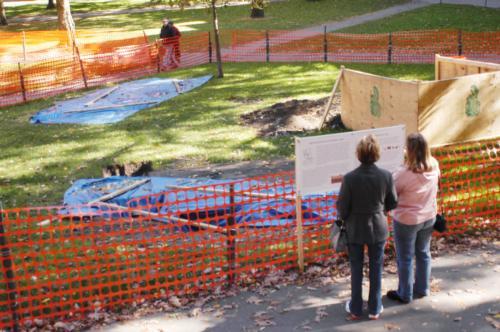
Can You Dig It?
Attention misled treasure hunters: there isn’t actually a gold-ridden burial ground under Matthews Hall.
The orange tape and big holes in the yard are the work of Anthropology 1130, a hands-on archaeology class looking for the foundations of Harvard’s Indian College. So far, the 42 students enrolled in “Archaeology of Harvard Yard” have unearthed shellbuttons, wine bottles, pipestems, bits of Chinese porcelain, and (surprise!) plenty of brick. The most exciting discovery to date are small pieces of printing tile that may have been used to produce the first Bible printed in North America.
“It’s so easy when you’re walking through the yard to ignore Harvard’s history,” says amateur archeologist Devon E. Sherman ’10. “This class forces you to stop and think about the fact that people have been walking across this yard for hundreds of years.”
If the term “Indian College” makes you think of stuffy Puritans brandishing Bibles and spreading smallpox to the native population, you’re only half right.
Founded in 1655, the Indian College educated English and native students side by side as part of an effort to teach English and Protestantism to local tribes. Unfortunately, seventeenth-century graduation rates weren’t what they are today; of the five attendees, one dropped out, two died of disease, and one was murdered. The only graduate died of tuberculosis shortly after receiving his degree.
For Tiffany L. Smalley ’11, a member of the Aquinnah Wampanoag tribe, Anthropology 1130 lets her study the history of her people mere feet from her dorm. “I think it’s really cool that Matthews is supposed to be the site of the first indian college,” said the Matthews resident. “I thought it was really coincidental that I was put there and my ancestors lived there.”
Kind of gives new meaning to the term “legacy student,” doesn’t it?


